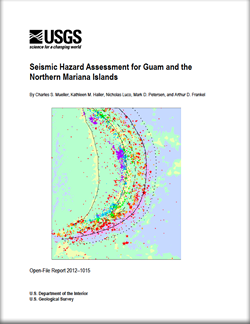 Abstract Abstract
We present the results of a new probabilistic seismic hazard assessment for Guam and the Northern Mariana Islands. The Mariana island arc has formed in response to northwestward subduction of the Pacific plate beneath the Philippine Sea plate, and this process controls seismic activity in the region. Historical seismicity, the Mariana megathrust, and two crustal faults on Guam were modeled as seismic sources, and ground motions were estimated by using published relations for a firm-rock site condition. Maps of peak ground acceleration, 0.2-second spectral acceleration for 5 percent critical damping, and 1.0-second spectral acceleration for 5 percent critical damping were computed for exceedance probabilities of 2 percent and 10 percent in 50 years.
For 2 percent probability of exceedance in 50 years, probabilistic peak ground acceleration is 0.94 gravitational acceleration at Guam and 0.57 gravitational acceleration at Saipan, 0.2-second spectral acceleration is 2.86 gravitational acceleration at Guam and 1.75 gravitational acceleration at Saipan, and 1.0-second spectral acceleration is 0.61 gravitational acceleration at Guam and 0.37 gravitational acceleration at Saipan.
For 10 percent probability of exceedance in 50 years, probabilistic peak ground acceleration is 0.49 gravitational acceleration at Guam and 0.29 gravitational acceleration at Saipan, 0.2-second spectral acceleration is 1.43 gravitational acceleration at Guam and 0.83 gravitational acceleration at Saipan, and 1.0-second spectral acceleration is 0.30 gravitational acceleration at Guam and 0.18 gravitational acceleration at Saipan.
The dominant hazard source at the islands is upper Benioff-zone seismicity (depth 40–160 kilometers). The large probabilistic ground motions reflect the strong concentrations of this activity below the arc, especially near Guam.
|
This report is presented in Portable Document Format (PDF); the latest version of Adobe Reader or similar software is required to view it. Download the latest version of Adobe Reader, free of charge. |